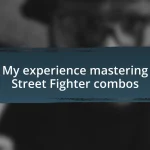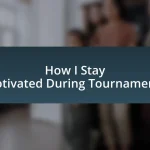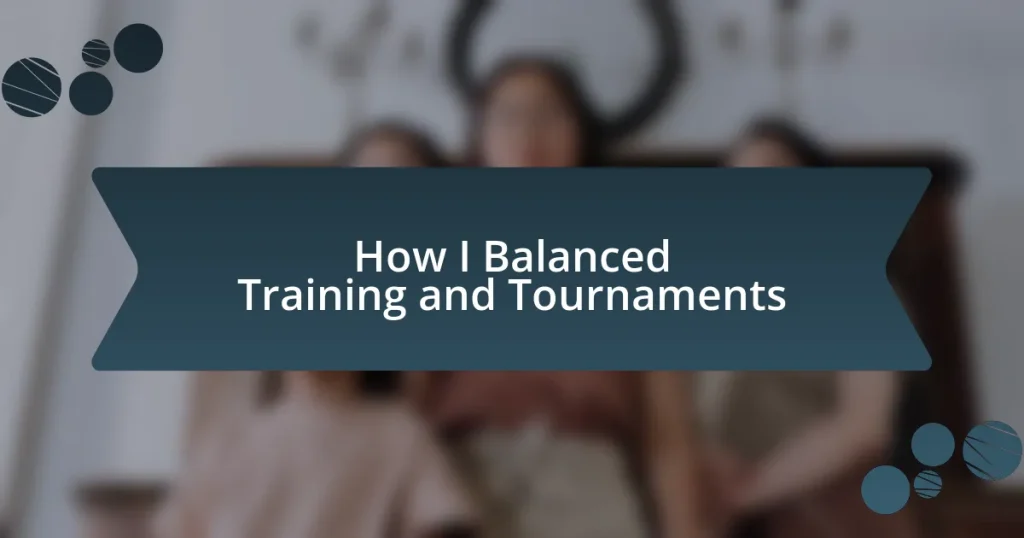Key takeaways:
- Finding balance in training and competitions enhances long-term success, including physical and mental wellness.
- Identifying short-term and long-term goals, along with aligning them to personal values, is crucial for a fulfilling training experience.
- Incorporating rest and recovery is essential; it rejuvenates both physical and mental well-being, allowing for better performance.
- Strategically selecting tournaments based on personal goals and timely recovery is vital for optimal competition performance.
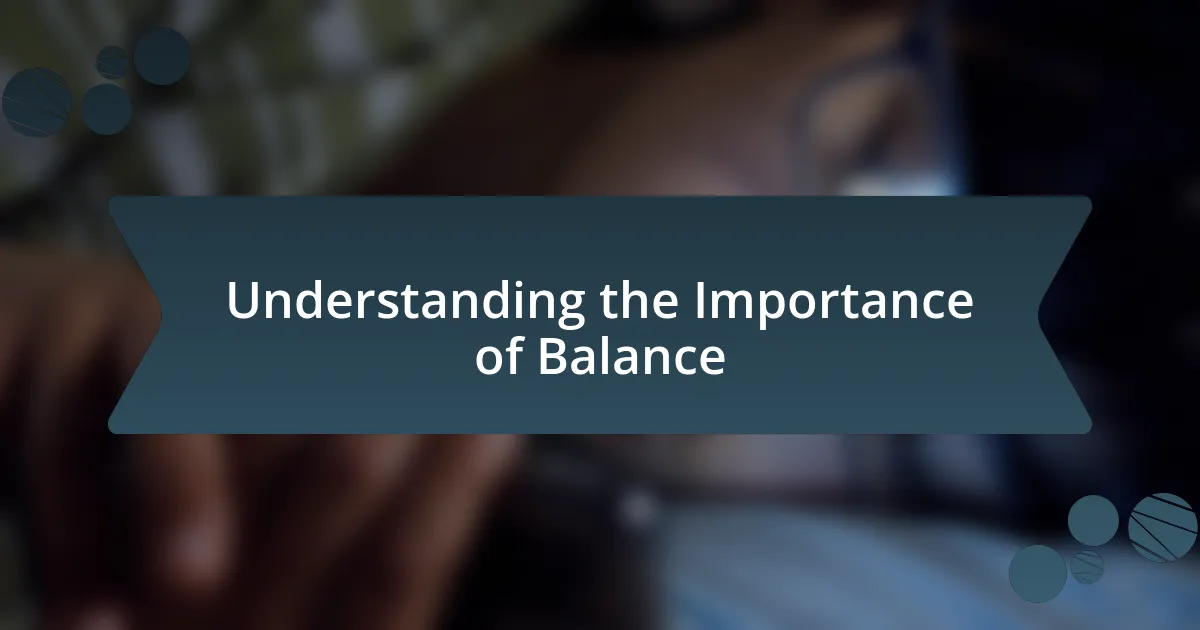
Understanding the Importance of Balance
Finding balance in training and tournaments is crucial for long-term success. I remember a time when I was so focused on winning that I neglected my health. The fatigue started to weigh on me, and I questioned, “At what cost am I pursuing these victories?” It took a toll not only on my performance but also on my passion for the sport.
Balance allows us to maintain our physical and mental wellness while still striving for excellence. During a particularly intense training period, I learned that integrating rest and recovery into my routine made me feel more energized and motivated. It’s essential to ask ourselves: Are we pushing too hard? Recognizing when to pull back can be just as powerful as any training session.
Ultimately, balance cultivates resilience. I recall a tournament where I had to draw upon both my training and my emotional strength to navigate challenges. It highlighted that success isn’t only about rigorous training; it’s also about nurturing our well-being and making sure we enjoy the journey. Isn’t it more fulfilling to compete while feeling strong and excited rather than burnt out and overwhelmed?

Identifying Your Training Goals
Identifying your training goals is the first step in creating an effective balance between training and competition. I recall setting performance goals that pushed me to focus solely on the outcomes rather than the process. This shift in mindset alone can make a monumental difference in how you approach both training and tournaments; remember, it’s not just about where you want to be, but also about how to get there effectively and sustainably.
One key element is to distinguish between short-term and long-term goals. When I first started, my focus was on immediate results, but I soon realized that nurturing longer goals provided the necessary structure and motivation. For instance, instead of merely wanting to win a single tournament, I began targeting a series of tournaments and allowing space for growth in between. This holistic approach helped me prioritize skills that would translate better in varied competitive scenarios while keeping burnout at bay.
Additionally, aligning your training goals with personal values can create a more fulfilling experience. I find that when I set goals that resonate with my passion for the sport, I’m more likely to stay committed. Ask yourself what you truly enjoy about competing and how that can inform your training. When I integrated fun drills that focused on creativity, I noticed not only my performance improved, but my love for the game reignited.
| Type of Goals | Description |
|---|---|
| Short-term Goals | Focus on immediate performance metrics and outcomes. |
| Long-term Goals | Emphasize skills development and sustainable progress over time. |
| Personal Values | Align training objectives with what you truly enjoy to enhance commitment. |
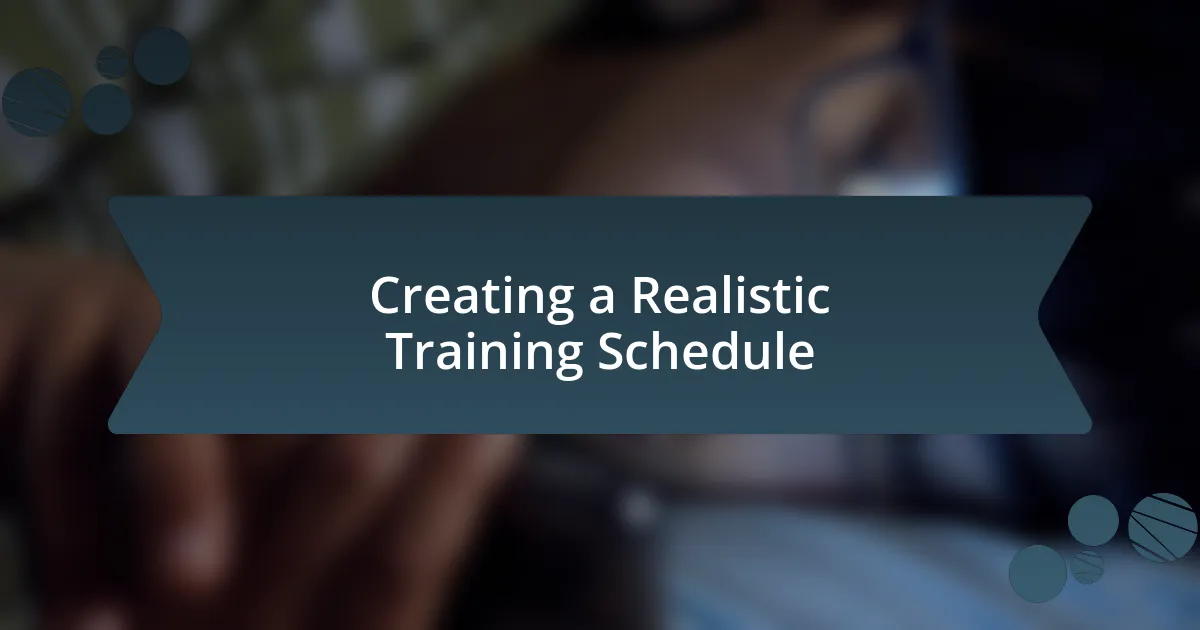
Creating a Realistic Training Schedule
Creating a training schedule that fits your lifestyle doesn’t have to be complicated; it just requires a thoughtful approach. I remember the early days when my enthusiasm led me to over-schedule myself, cramming sessions in every available hour. It wasn’t long before I felt drained and unmotivated. A realistic schedule should include not just training, but also rest, to maintain both physical and mental well-being.
Here’s how I developed a balanced training schedule that works for me:
- Assess Available Time: I started by mapping out my week, identifying true blocks of time I could dedicate to training without feeling rushed.
- Prioritize Training Sessions: Each week, I prioritized quality over quantity. Instead of squeezing in five short sessions, I aimed for three focused ones.
- Include Rest Days: I learned the hard way how crucial rest days are. These days allow my body to recover and my mind to recharge, ultimately leading to better performance.
- Be Flexible: Life happens, so I built in flexibility. If a tournament or personal commitment came up, I’d adjust my training days without guilt.
- Reflect and Adjust: Every month, I’d review what worked and what didn’t. I realized some weeks required more rest, while others called for additional intensity.
Balancing life and training is an ongoing process, and listening to my body and mind has undoubtedly been one of the best lessons I’ve learned along the way.
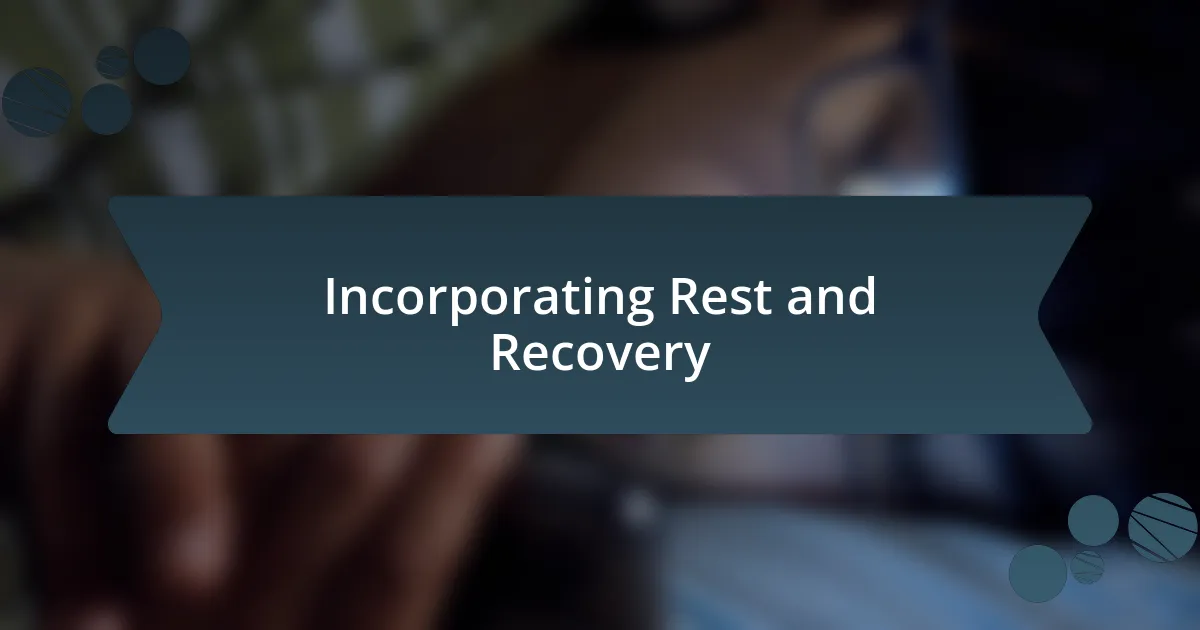
Incorporating Rest and Recovery
Incorporating rest and recovery into my training was a game-changer. I recall a particularly intense season where I pushed myself to the brink, thinking more training meant better results. But as fatigue set in, I found myself dragging through practices, barely able to focus or give my best effort. Realizing this was an eye-opener; sometimes, rest is what we need to truly excel.
I started listening to my body. If I felt sluggish or off, I embraced it as a sign to take a break. The emotional lift I experienced on rest days often spiraled into a more positive mindset when I returned to training. Have you ever noticed how taking a day off can reignite your passion? It did for me. Those moments away from the grind brought clarity and renewed motivation, allowing me to tackle each session with fresh energy.
Recovery isn’t just physical; it’s mental, too. I’ve found engaging in activities like light stretching or yoga during rest days helps clear my mind. These gentle practices provide a mental reset, ensuring I’m not just resting my muscles but also rejuvenating my spirit for the challenges ahead. After all, how can we perform at our best if we’re not taking care of the whole person?
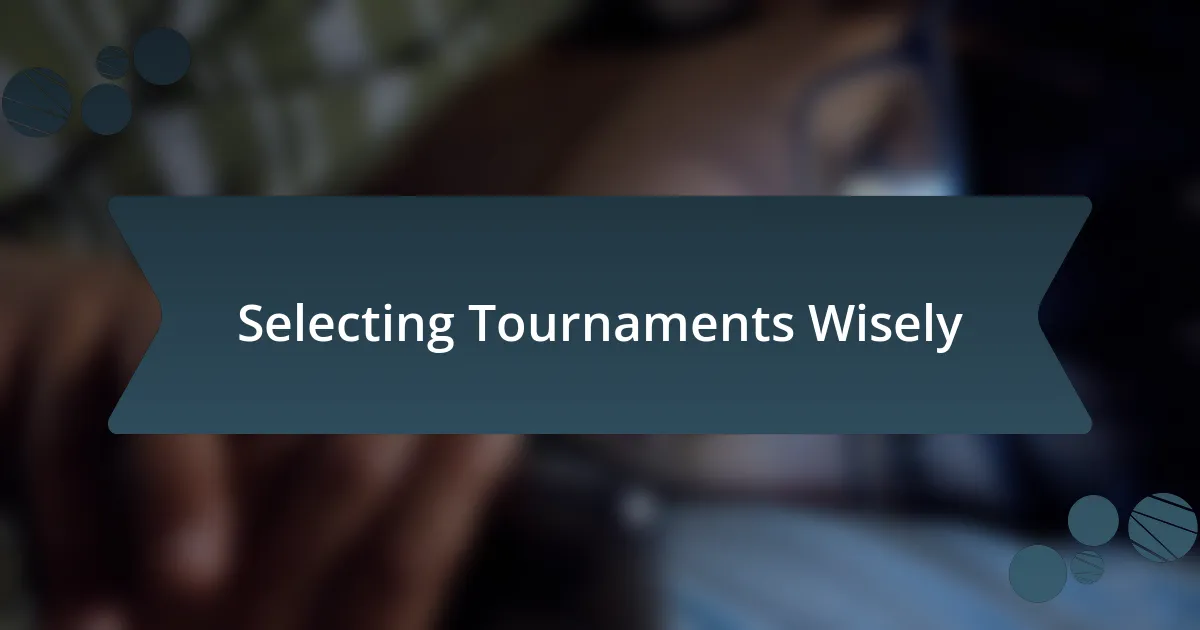
Selecting Tournaments Wisely
When it comes to selecting tournaments wisely, I’ve learned that not every competition is worth my time and energy. Early in my career, I signed up for every tournament that came my way, thinking it would boost my experience. I quickly realized that the quality of the event—like the level of competition and how it aligns with my skill set—matters far more than sheer quantity. Have you ever felt burnt out from overcommitting? I certainly have.
Now, I take a strategic approach, looking for tournaments that challenge me but also support my growth. For instance, I remember entering a regional event that seemed daunting. This experience not only pushed my limits but also helped me gain insights into areas needing improvement. Choosing tournaments that align with my goals has not only enhanced my performance but also made the whole journey more enjoyable.
Timing is another crucial aspect I consider. I once made the mistake of entering a major tournament right after a grueling training block, without giving myself enough recovery time. The result? I felt underprepared and didn’t perform my best. Planning my tournament schedule thoughtfully now helps me ensure I’m at peak performance. Don’t you think that feeling fully prepared is essential for achieving your best results? I certainly do.
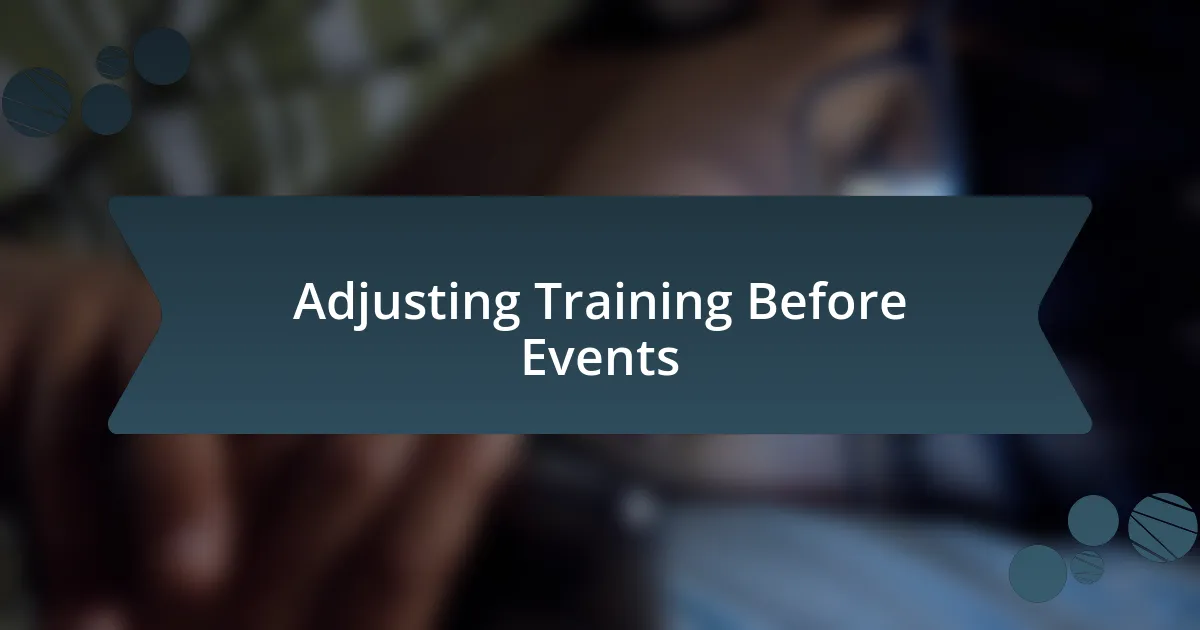
Adjusting Training Before Events
Before a big event, I always take a moment to adjust my training routine. I remember the time I had a crucial tournament coming up, and I realized that I needed to dial back my intensity. Instead of pushing my limits in the weeks leading up, I focused on refining my techniques and sharpening my strategy. Have you ever noticed how a lighter workload can actually lead to better performance? It definitely worked for me.
I also implement specific drills tailored to what I anticipate facing in competitions. For example, if I know I’ll be up against opponents who specialize in a certain technique, I’ll incorporate drills that counteract that. It’s fascinating how a focused approach can ease pre-competition jitters, don’t you think? By honing in on particular skills, I feel more equipped and confident when stepping onto the competition floor.
Recovery becomes a top priority as the event nears. I’ve learned the hard way that neglecting rest can lead to fatigue, which ultimately affects my performance. I recall one tournament where I underestimated the importance of sleep and wound up feeling sluggish. Just as our body craves physical preparation, it also requires time to recharge. Isn’t it remarkable how much of a difference proper recovery can make? It’s a crucial lesson I carry with me every time I prepare for a competition.
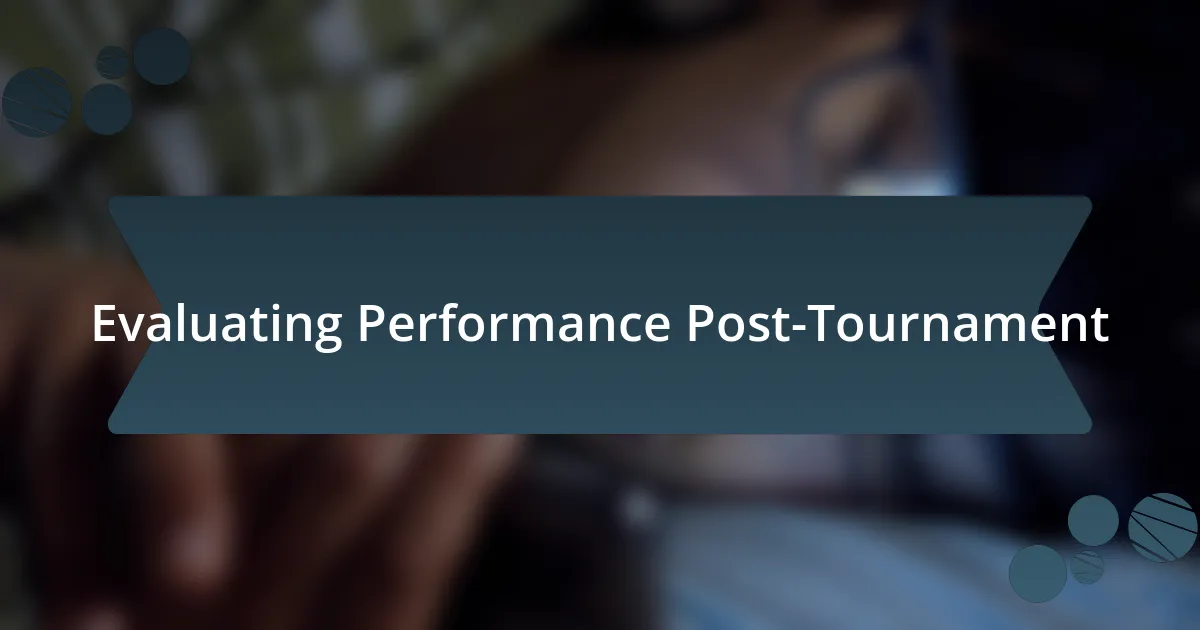
Evaluating Performance Post-Tournament
Reflecting on my performance after a tournament is a critical step for me. I always take a quiet moment to analyze not just the outcome but also my approach during the matches. I recall one competition where I performed well but realized I could have better managed my nerves. It begs the question: how often do we let anxiety dictate our performance, overshadowing our training?
There’s something invaluable about reviewing match footage. I remember a time when I meticulously analyzed my last tournament’s recordings. I jotted down my strengths and weaknesses, noticing patterns in my decision-making that I hadn’t been aware of during the heat of the moment. This process gave me clarity and direction—without it, I feel I’d be navigating my training blindly. Have you ever found that watching yourself can reveal insights you might miss in the moment?
Feedback is another vital component of my post-tournament evaluation. I often seek input from coaches and teammates, which can be tough to digest at times. I recall a situation where a coach pointed out my over-reliance on one technique, challenging me to diversify my skill set. Initially, it stung, but I realized this constructive criticism was a pathway to growth. Isn’t it amazing how the discomfort of honesty can propel us forward in our journey?

